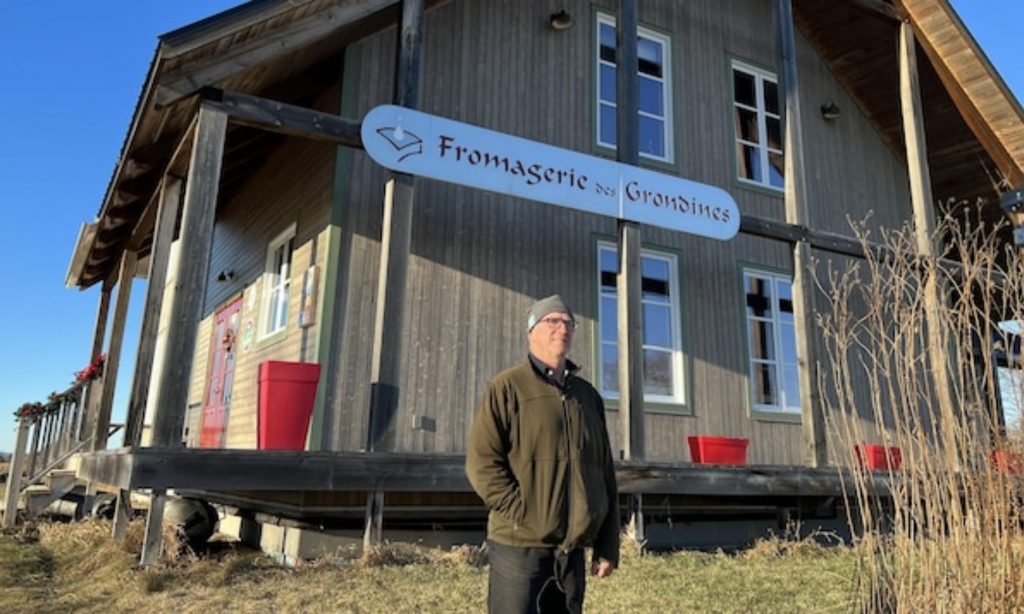
If the Canada-Europe free trade agreement smiles on Canadian retailers and dairy giants, happy to he market of European cheeses purchased at low prices, Quebec cheesemakers, like Charles Trottier, are struggling to get by.
Charles Trottier produces organic cheese at Fromagerie des Grondines.
A report by Lisa Bonte, Arthur Cremers, Lori Isbister, Anaël Rolland-Balzon, Alban Normandin and Nadia Agamawy, from the DESS in journalism at the University of Montreal.
Charles Trottier produces organic cheese at Fromagerie des Grondines, in the Quebec region. He is one of the Quebec cheese producers who have adapted their production for today’s challenge: the fight against global warming.
But since the provisional entry into force of the Comprehensive Economic Trade Agreement (CETA) five years ago, its cheeses have struggled to remain competitive with European products. The latter are more profitable for retailers because the profit margins are greater. For example, in seven years, Charles Trottier claims to have lost 70% of his sales at IGA. They [don’t] want [our cheeses], he explains.
For his part, Jean Morin, owner of the Fromagerie du Presbytère in Warwick, is worried about the competition facing his cheeses, such as Louis d’Or, because they are sold for twice as much as their European competitors, such as French Comté and Swiss Gruyère. According to him, the impact of the agreement will lead to a decrease in sales of Canadian products. To the detriment of Canada, we are looking for imported products, he laments.
And his concerns are far from unfounded, because according to Charles Langlois, of the Council of Dairy Industrialists of Quebec, in the next four to five years, the majority of medium-sized companies will disappear, especially if they manufacture products which are similar [to those of] European companies.
Since 2017, nearly 52,000 tonnes of European cheese have been imported under tariff quotas or special access rights. In 2022, this would be the equivalent of the production of 400 Grondines cheese factories imported into Canada without customs duties.
What is a tariff quota?
A tariff quota is a mechanism that allows the total or partial elimination of customs duties on a specific type and quantity of goods, for a specified period.
To mitigate financial losses due to the importation of foreign products, half of the CETA tariff rate quotas for cheeses have been allocated by Ottawa to Canadian cheese manufacturers. However, only giants like Agropur, Saputo or Lactalis Canada have the distribution structures to take advantage of these quotas.
The big players in dairy processing, which operate on a very large scale, are also less affected than small producers by European imports. They invade the retail market with their cheaper industrial products, in addition to importing high-end European products, sold at a profit to retailers. Thus, they fully benefit from the agreement between Canada and Europe.
Charles Trottier, meanwhile, is indignant at also receiving tariff quotas: If you accept it, you cannibalize your own market, which is nonsense.
Charles Trottier among his creations.
In the end, Canadian retailers are the big winners from this deal. Under pressure from major retail players like Loblaws, Costco and Metro, the Canadian government granted the second half of the tariff quotas to Canadian retailers and distributors. They buy European cheeses at low prices and add a margin of around 40%. The consumer therefore does not benefit from the reduced prices of imported European cheese, argues Maurice Doyon, professor of economics at Laval University.
According Stéphane Lacasse, of the Quebec Food Retailers Association, retailers are proud to encourage the local cheese industry and he maintains that the vast majority of cheeses sold in grocery stores are Quebec products and Canadians.
According to a distributor, retailers have never supported Quebec products so much. He explains that the biggest impediment to [manufacturers’] sales and competitiveness is the price of Canadian milk.
Start of the widget. Skip the widget?
End of widget. Back to top of widget?
Canadian dairy farmers were compensated for the loss of their sales to processors. Financial assistance of $1.75 billion from public funds was provided to them in the form of direct payments.
Basically, we are paid not to produce milk that we will give [to Europeans] in the form of an import quota, Charles Trottier is indignant. The citizen who pays taxes is entitled to ask himself if it is logical that so much money is given to an industry on a recurring basis in order not to produce.
For François Dumontier, of the Quebec Dairy Producers, the growth [of the dairy industry] is reduced forever […]. Producers are compensated at this time, but will not be indefinitely. We may fall into a decline in the dairy industry.
According to Pierre Marc Johnson, Quebec’s chief negotiator for CETA, Canadian negotiators were aware that they could not get a deal without giving anything up: This is the reality. Everyone knew that when it came to agriculture, there would be concessions to be made on both sides.
The dairy industry served as a bargaining chip for beef , is indignant Charles Trottier. He criticizes Canada’s obligation to import the full set cheese quotas, while Europe is not obliged to import beef products.
In fact, few cattle producers can export because they use antibiotics and hormones banned in the European Union. Even producers who do not use these products are unable to obtain the necessary certification.
Getting your breeding certified is extremely difficult, regrets Kirk Johnson, producer and spokesperson for the Canadian Cattle Producers’ Association. It confirms that many more Canadian farms could export to Europe if there were more members authorized to issue certification.
Start of the widget. Skip the widget?
Source: Eurostat
End of widget. Back to top of widget?
In the case of beef, only 3% of quotas under the deal crossed borders last year. According to Eurostat, Canada exported only 1,396 tonnes of beef to the EU in 2021. On the other side, European beef imports jumped to 12,156 tons.
According to Pierre Marc Johnson, negotiator for Quebec in 2017, this was to be expected: I’m not sure the West was ready to export [beef] in the quantities that the quotas claimed or even obtained.
For its part, Agriculture and Agri-Food Canada says the federal government remains committed to increasing immediate capacity to export more eligible beef and veal products to the EU market in order to use tariff rate quotas in the short term.
Cranberry: between success and ecological vagueness
One of the great pairing hits is probably to be found on the cranberry side. According to Geneviève Brisson, General Delegate of Quebec in Brussels, sales of small red berries in the EU have increased by 288% in five years. Nevertheless, many environmental unknowns related to their production remain. Conventional agriculture is particularly questioned because of the large quantities of water used and the chemical interventions required.
Pierre Marc Johnson does not hesitate to confirm this: I can tell you that when it comes to trade agreements, [environmental issues] are very far from taking first place in the concerns expressed by the parties.
According to Nicolas Roux, spokesperson for the NGO Friends of the Earth, free trade agreements promote the development of industrial agriculture, a major CO2 emitter, to the detriment of smaller local farms. Claude Vaillancourt, president of Attac-Québec, agrees with this postulate: Free trade agreements are made for companies that can produce in large volumes and, in general, it is an industrial mode of production that is quite harmful. for the environment.
Cheese is one of the foods on the plate of Quebecers with the heaviest environmental impact. Producing one kilo of cheese (all kinds combined) emits about 1.5 times more GHGs than producing one kilo of pork, and about 2.3 times more than producing the same amount of chicken. Beginning of the YouTube widget. Skip widget?
End of YouTube widget. Back to top of widget?
Furthermore, making a single kilo of cheese requires between 3000 and 6000 liters of water when the whole production chain is taken into account.
Dominique Maxime, an expert in sustainability and the environment in milk production, adds that Quebec milk would emit less CO2 than French milk, one of the main European cheese exporting countries. Indeed, a recent study by the Institute for Agriculture and Trade Policy (IATP) shows that the carbon footprint of European dairy and meat giants competes with that of fossil fuel giants. However, these are not subject to the same public scrutiny and can therefore act without being held accountable for their climate impact.
Charles Trottier worries about distant goals and the dairy industry’s slow transition to green production: Dairy farmers are putting a lot of effort into presenting their plan carbon neutrality, but we’re talking about 2050. In 2050, if we don’t do anything, the planet will crack everywhere.






















